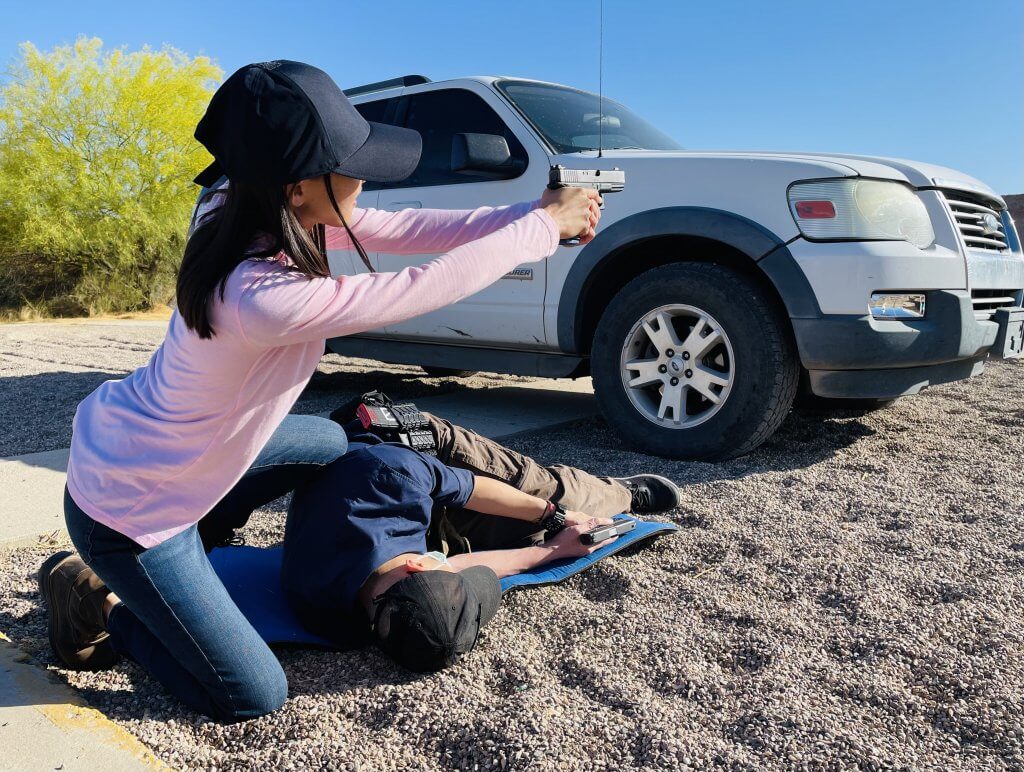Wind Turbines and Highway Signs

For God’s sake, stop shooting them.
It pains me to have to write this.
Chances are, if you’re reading this, you’re not the type of illiterate nutsack who would shoot at a windmill. Chances are you don’t even know anybody who does. But somebody somewhere does.
*****
The View from Vandenberg
When I was a cadet at the Air Force Academy in the early 1980s, we didn’t have much spare time, but my classmate Steve and I would occasionally take a moment to ponder. We’d lean on the Terrazzo-level railing on the east end of Vandenberg Hall, gazing out at the cumulonimbus boiling up over the plains, perhaps as far away as Kansas. Between us and the vast horizon lay the beautiful pine-strewn Academy grounds, Interstate 25, a wide strip of yellow-grass prairie, and at the top of distant hills, Colorado’s Black Forest–dotted with only a few houses in those days.
Forty years later, that same view of I-25 is dominated by commercial buildings. The plains & woods east of USAFA are strewn with cookie-cutter houses.

People keep having babies, which I’m all for–it’s necessary if our species is to continue. Since working from home became a thing, people on the crowded, expensive, over-regulated coasts have been fleeing to the simpler, less expensive, less crowded flyover states, bringing all those problems with them. I suppose more housing developments are inevitable.
Having to get through the academics of the Academy before getting commissioned as lieutenants couldn’t be helped, either (and still can’t, for today’s cadets). We were frustrated warriors, like half-grown lion cubs pacing in a cage, waiting for our turn in the arena. In the early Spring of ’83, Steve lamented to me:
“The Soviets are gassing people in Afghanistan, the Polish want to go on strike, but they won’t let ’em, and we’re sitting here watching it snow up in the mountains.”
*****
The Great American Pastime
When the Polish labor unions were trying to strike against the communist regime, their union leader Lech Walesa was imprisoned, and protesting crowds were getting knocked down by water cannons, a Tucson PD officer I knew made a sardonic remark about “the great American pastime.”
“What’s that?” I asked.
“Driving down the road, shooting the 55 mile an hour signs, and throwing the empty Coors cans in the back,” he replied. Then he added, “They can’t do that in Poland.”
He was, of course, being facetious. His comment wasn’t about the lack of freedom in the Warsaw Pact–although there was precious little freedom in the Soviet satellite states. He was sardonically passing judgment, instead, on an American tradition. I’m all about tradition, but this one needs to go away.
In 1973, the Organization of Petroleum Exporting Countries put the squeeze on us, driving up prices, by shutting off the tap (OPEC did it again in ’79). “Oil is not bubble gum,” Dr. Jerrold Green told me, “There is no great elasticity of demand. Without oil, the world comes to a halt.” In a largely futile attempt to reduce demand, Congress passed the Emergency Highway Energy Conservation Act in 1974, capping speed limits nationwide at 55 mile per hour.
Americans universally reviled the 55 mph limit, particularly out West, where the roads were so straight and the distances between towns so vast. Sammy Hagar sang that he couldn’t drive 55. Neither could the rest of us. It was raised to 65 in the late 1980s. The law was not repealed until 1995.
One could rationalize that shooting 55 mph signs was a form of libertarian social disobedience.
Two great big .45 caliber holes in that rationalization, pun intended:
- Speed limit signs weren’t the only ones being shot.
- None of the signs I saw with bullet holes in them were removed and placed in front of a backstop on a shooting range–not even a “wildcat” range on public land.
A hunter on his way to the woods might verify his scope’s zero by taking a shot or two at a “leaping deer” sign by a deserted stretch of road.

Lobbing bullets over a hill, parallel to a road that might have a car you can’t see on the other side, is dangerously irresponsible.

*****
Reckless Endangerment
While I was in Colorado Springs, some young men I knew were driving on two-lane blacktops in the desert east of Tucson, shooting road signs. Alcohol may have been involved. They were not even remotely concerned about Rule 4, being sure of what’s behind your target. I don’t think anybody had ever ever told them the Rules of firearms safety.
Thus, no one was more surprised than them, when they shot at a stop sign, only to learn later that behind it there was a Pima County deputy parked in the shadows, waiting to catch anybody driving through the intersection without stopping. Their .357 bullet practically went across his hood.
Not being a great fool, the deputy–who thought they were shooting at him–did not pursue them with lights and sirens blaring.
Rather, he radioed ahead.
Then he followed, discretely, at a distance, to track their location.
When the hapless trio got to another road junction, they found several police cruisers parked across it. Unhappy men in uniform were pointing shotguns at them. Stepping out of the car, one at a time, as instructed, they heard phrases like “Move a muscle and you’re a dead man, cop killer.”
Their little bit of wanton ballistic vandalism garnered them reckless endangerment convictions.
I knew those guys, and didn’t hate them, but they were being idiots. Would that more idiots like them got caught and convicted.
*****
Wind Turbines Don’t Fix Themselves
Not too long ago I took a trip to the Pacific Northwest to train Bleeding Control instructors of Avangrid Renewables, an energy company (more recently, we did another “train the trainer” for them in South Dakota).
I had seen such turbines, from a little distance, before. There are now a few adjacent to my old PD’s firing range.

Avangrid took us on a tour of a wind farm south of the mighty Columbia River. We got to climb around inside one of their trainers. The nacelles are the size of an RV–a lot bigger than they look when they’re up on that big stick.

Lots of reduction gears and such in those things that can rip off a finger or hand.
“So apart from mechanical dismemberment, your main other emergency medical concerns are falls?” I asked.
There are no dumb questions, but there are dumb people like me asking questions. They looked at me blankly for a few moments. One dared to state what I should have found obvious.
“No, falls aren’t too much of a medical problem on a wind farm,” he replied. “If somebody takes a spill from 300 feet, he won’t need first aid.”
Duh.
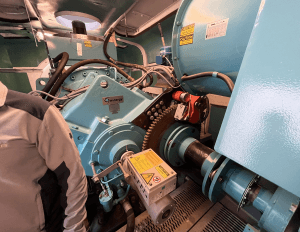
I was surprised to learn, however, that their technicians working on generators or gearboxes inside the nacelles, those big boxes in the sky, will suddenly hear a cracking metallic pop, with light simultaneously coming in from a .30 caliber hole in the side of the nacelle. They wanted us to teach them how to treat GSWs: gunshot wounds.
The technicians ascend inside of the tower to do their jobs. Unless he or she climbs out the top of the nacelle to access the pitch mechanism in the rotor hub, there is no way to tell from outside if there’s a technician up there or not. There might be a work truck parked by the base of the tower, but if they got dropped off by a buddy working on another turbine, there might not.
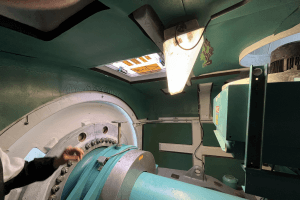
If someone is shot or otherwise injured in a nacelle, they have to be lowered (or lower themselves) from up there in a harness like this.

Responding ambulance crews are not likely trained and less likely equipped for high angle rescue. And that’s not the worse part. Wind farms are typically miles and miles from the nearest Level 1 trauma center. That’s why they needed to learn how to take care of themselves, medically.
*****
The Formerly Unspoiled West
I grew up in New Mexico, Arizona, and the high desert of California. I went to school in Oregon, as well as Colorado, and spent my summers growing up in Washington State and Idaho. I’ve “ridden the range” on the plains of Wyoming and Nebraska, as well as southmost Texas. I never strapped myself to half a ton of angry hamburger, nor participated in any other rodeo competition, but I liked watching the chuckwagon races when I lived across the street from Frontier Park in Cheyenne. I love the wide-open spaces of the American West.
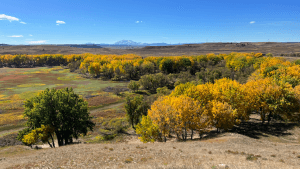
Once when I was hunting antelope in the Bighorn Basin, I paused on the crest of a small spine (if I read my USGS map correctly, it was Cedar Ridge, but I saw no cedars), planning my route down some switchbacks. Looking east-northeast, I could see the western side of the Bighorn range. About the only manmade things I could see were my Jeep Scrambler and the two dirt ruts I rode in on. I felt so blessed to have nearly the same vistas to look at as the Sioux and the Mountain Men.
That was decades ago. Sadly, the unspoiled west is no longer that unspoiled.
*****
Windmills and Wind Turbines
I must admit I find wind turbines to be a trifle annoying. There aren’t any in my back yard, nor in the places where I typically hike or camp. I’m the type of camper who likes to listen to the quiet and look at the stars. At night, near a wind farm, one hears the constant hum of their operation. You see the flashing red lights on top of each. If you’re the type of camper who blasts their stereo loud enough to be heard a mile away, wind turbines probably don’t bother you all that much.
Leasing or selling land to wind farms is one way for ranches that have been around since they were taken from the natives and the wolves, yet are “land rich and money poor,” to pay their property taxes and stay in operation.
I haven’t seen Tyler Sheridan’s Landman, but I like his other work. I’m told Billy Bob Thornton’s character makes some valid points about how the effort involved in building the components, shipping them, and erecting them into a windmill adds carbon to their footprint. Can’t say I know anything about the energy business, but I’m guessing that a wind farm is more eco-friendly than a coal fired power plant, even if it’s far from “net zero.”
I do know this: you’re reading this on a computer, or perhaps on paper indoors. You probably have and use air conditioning. All require electrical power. Power to which Americans, left and right, even environmentalists, are voraciously addicted. We’ve been hooked ever since Edison and Tesla showed us we don’t need to read by candlelight after the sun goes down.
California has “rolling brownouts” and blackouts like a third-world country. “We have too much electrical power,” said nobody, ever. So why the vociferous (and sometimes ballistic) opposition to wind turbines? We need every source we can get–including oil, coal, gas, solar, hydro, and nuclear (no, I don’t think we should be cutting down trees in cloudy Minnesota for solar farms; but here in Arizona, we have more sunshine than we need).
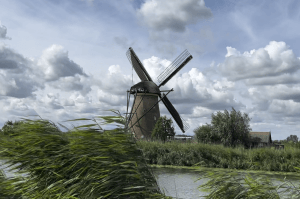
Windmills in Holland are a UNESCO World Heritage treasure. The American West was settled by ranchers who used smaller metal windmills to pump water to their cattle troughs. Most of us find both picturesque. Yet the sight of a modern wind farm sends some into fits of apoplexy.
Having worked outdoors in Wyoming and Nebraska, I can tell you from bitter experience the one thing they have too much of on the high plains is wind. Why not harness it?

*****
NOT a Legit Form of Protest
If “I don’t like them” is the only criterion for whether or not it’s OK to shoot at something, why stop there? I think freeway overpasses are unsightly. Does that mean it would be OK to blow one up while people are driving on it? I’m not fond of people who feel entitled. Plenty of them in shopping malls. Would it be OK to shoot up a mall? Of course not.
So why do some idiots think it’s OK to shoot at wind turbines? Good Lord! If you didn’t know before, you know now: there could be PEOPLE up in there. Hard working people, citizens of the American West (usually, small towns in the West) who just want to feed their families. Their crime is providing us with electricity.
If you consider yourself some sort of environmental activist, you can start by reducing your lead contamination.
*****
Transformers Targeted
Some Bozos enjoy shooting at power transformers. Apparently, it makes pretty sparks.
Apart from driving up power rates, starting enormously destructive wildfires, and risking the lives of those sent up there to repair them, every shot into a transformer or a power line insulator is one more nail in the coffin of our precious right to protect ourselves with effective tools like firearms.
Oh, and not for nothing, but older transformers leak highly carcinogenic and forever persistent PCBs, polychlorinated biphenyls, into the ground water when they’re hit.


When I served on a FBI joint terrorism taskforce (JTTF), I learned that terrorist groups like al Qaeda target our electrical infrastructure to get attention, destabilize us, and harm our economy. I’m guessing the Communist Chinese and other near-peer potential enemies have quite thoroughly mapped out our electrical grids and made plans to disrupt them in the event of war, or simply to undermine us as part of great power competition.
Why do their work for them, just ‘cause you’re bored and happen to have a gun? I’m a huge fan of the Second Amendment, and the rest of our Constitution. I’m also a fan of putting criminals who endanger others with their guns, giving East-Coast politicians an excuse to take mine, in jail.
Again, I’m sure nobody reading this article needs to be told this stuff. But chances are, you or somebody you know may be acquainted with someone who does. If you hear them bragging about shooting signs, you need to call them on it.
If you hear about someone shooting at wind turbines, transformers, or other parts of our nation’s vital electrical infrastructure, go to fbi.gov and click on Submit a Tip.
–George H, concerned, responsible gun owner
